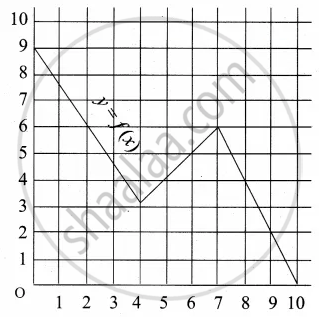Advertisements
Advertisements
Question
If f : R → R be given by for all \[f\left( x \right) = \frac{4^x}{4^x + 2}\] x ∈ R, then
Options
(a) f(x) = f(1 − x)
(b) f(x) + f(1 − x) = 0
(c) f(x) + f(1 − x) = 1
(d) f(x) + f(x − 1) = 1
Solution
(c) f(x) + f(1 − x) = 1
\[f\left( x \right) = \frac{4^x}{4^x + 2}\]
\[f (1 - x) = \frac{4^{1 - x}}{4^{1 - x} + 2}\]
\[ = \frac{4}{2 \times 4^x + 4}\]
\[ = \frac{2}{4^x + 2}\]
\[f(x) + f(1 - x) = \frac{4^x}{4^x + 2} + \frac{2}{4^x + 2} \]
\[ = \frac{4^x + 2}{4^x + 2} = 1\]
\[\]
APPEARS IN
RELATED QUESTIONS
Let A = {−2, −1, 0, 1, 2} and f : A → Z be a function defined by f(x) = x2 − 2x − 3. Find:
(b) pre-images of 6, −3 and 5.
Let f : R+ → R, where R+ is the set of all positive real numbers, such that f(x) = loge x. Determine
(a) the image set of the domain of f
f, g, h are three function defined from R to R as follow:
(i) f(x) = x2
Find the range of function.
f, g, h are three function defined from R to R as follow:
(ii) g(x) = sin x
Find the range of function.
Let A = [p, q, r, s] and B = [1, 2, 3]. Which of the following relations from A to B is not a function?
If f(x) = loge (1 − x) and g(x) = [x], then determine function:
(iii) \[\frac{f}{g}\]
If f, g and h are real functions defined by
If f is a real function satisfying \[f\left( x + \frac{1}{x} \right) = x^2 + \frac{1}{x^2}\]
for all x ∈ R − {0}, then write the expression for f(x).
Write the range of the function f(x) = cos [x], where \[\frac{- \pi}{2} < x < \frac{\pi}{2}\] .
Let f : R → R be defined by f(x) = 2x + |x|. Then f(2x) + f(−x) − f(x) =
If \[e^{f\left( x \right)} = \frac{10 + x}{10 - x}\] , x ∈ (−10, 10) and \[f\left( x \right) = kf\left( \frac{200 x}{100 + x^2} \right)\] , then k =
f is a real valued function given by \[f\left( x \right) = 27 x^3 + \frac{1}{x^3}\] and α, β are roots of \[3x + \frac{1}{x} = 12\] . Then,
If f(x) = sin [π2] x + sin [−π]2 x, where [x] denotes the greatest integer less than or equal to x, then
The domain of the function
The domain of definition of the function f(x) = log |x| is
The range of the function \[f\left( x \right) = \frac{x}{\left| x \right|}\] is
If \[\left[ x \right]^2 - 5\left[ x \right] + 6 = 0\], where [.] denotes the greatest integer function, then
If f(m) = m2 − 3m + 1, find `f(1/2)`
If ƒ(m) = m2 − 3m + 1, find f(x + 1)
Which sets of ordered pairs represent functions from A = {1, 2, 3, 4} to B = {−1, 0, 1, 2, 3}? Justify.
{(1, 0), (3, 3), (2, −1), (4, 1), (2, 2)}
Which sets of ordered pairs represent functions from A = {1, 2, 3, 4} to B = {−1, 0, 1, 2, 3}? Justify.
{(1, 2), (2, −1), (3, 1), (4, 3)}
Find the domain and range of the following function.
f(x) = `root(3)(x + 1)`
Find the domain and range of the following function.
f(x) = `sqrt(16 - x^2)`
Express the area A of a square as a function of its perimeter P
Check the injectivity and surjectivity of the following function.
f : R → R given by f(x) = x3
Express the following exponential equation in logarithmic form
`"e"^(1/2)` = 1.6487
Write the following expression as sum or difference of logarithm
In `(("a"^3 ("a" - 2)^2)/sqrt("b"^2 + 5))`
If f(x) = 3x + 5, g(x) = 6x − 1, then find `("f"/"g") (x)` and its domain
The equation logx2 16 + log2x 64 = 3 has,
Let X = {3, 4, 6, 8}. Determine whether the relation R = {(x, f(x)) | x ∈ X, f(x) = x2 + 1} is a function from X to N?
Given the function f: x → x2 – 5x + 6, evaluate f(– 1)
Given the function f: x → x2 – 5x + 6, evaluate f(2)
A graph representing the function f(x) is given in it is clear that f(9) = 2

Describe the following Domain
If f(x) = `1/sqrt(4 - 3x)`, then dom(f) = ______..
Find the domain for which the functions f(x) = 2x2 – 1 and g(x) = 1 – 3x are equal.
Find the range of the following functions given by f(x) = 1 + 3 cos2x
(Hint: –1 ≤ cos 2x ≤ 1 ⇒ –3 ≤ 3 cos 2x ≤ 3 ⇒ –2 ≤ 1 + 3cos 2x ≤ 4)
Redefine the function f(x) = x − 2 + 2 + x , – 3 ≤ x ≤ 3
The domain of the function f defined by f(x) = `sqrt(4 - x) + 1/sqrt(x^2 - 1)` is equal to ______.
The ratio `(2^(log_2 1/4 a) - 3^(log_27(a^2 + 1)^3) - 2a)/(7^(4log_49a) - a - 1)` simplifies to ______.
